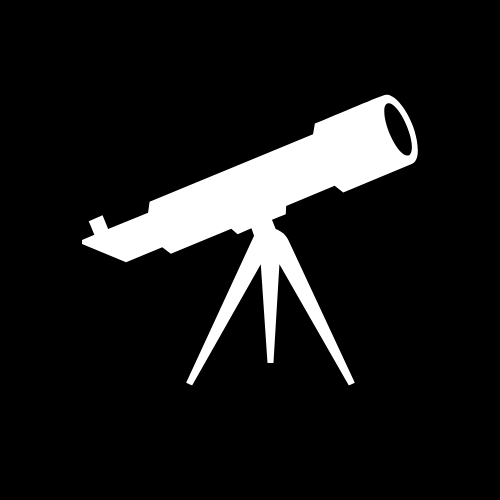Stargazing Apps
In an age where technology permeates every facet of our lives, it’s no surprise that the ancient and awe-inspiring practice of astronomy has also been touched by its transformative hand. From the times when our ancestors looked up at the night sky, tracing patterns and stories among the stars, to today, where we have the power of advanced telescopes that can peer into distant galaxies, the quest to understand our universe has been a constant.
Yet, as we stand at the crossroads of innovation and exploration, a new tool has emerged, making the wonders of the cosmos more accessible to everyone: stargazing apps. These digital companions, available at our fingertips, have democratized the field of amateur astronomy. No longer is a deep understanding of celestial movements or a high-powered telescope the entry ticket to the universe. With the rise of stargazing apps, all one needs is a smartphone or tablet to embark on a journey across the stars, planets, and other celestial wonders.
These apps, with their user-friendly interfaces, interactive charts, and augmented reality features, have revolutionized the way we interact with the night sky. They bridge the gap between seasoned astronomers and curious novices, offering a platform where both can marvel at the universe’s mysteries. As we delve deeper into this article, we’ll explore the top picks for stargazing apps, ensuring that your next night under the stars is nothing short of magical.
Why Use a Stargazing App?
The night sky, with its vast expanse dotted with twinkling stars, planets, and galaxies, has always been a source of wonder and curiosity. While traditional methods of stargazing using telescopes and star charts have their charm, the digital age offers tools that can significantly enhance our observational experiences. Enter stargazing apps, which have rapidly become indispensable tools for both seasoned and budding astronomers. But why should one consider using these apps? Let’s delve into the reasons.
Enhancing the Observational Experience:
Stargazing apps are not just digital star charts; they are comprehensive tools packed with features that can elevate your stargazing sessions. With augmented reality (AR) capabilities, these apps can overlay constellations, star names, and other celestial objects on your device’s live camera feed, allowing you to identify and learn about them in real-time. This interactive experience not only educates but also adds a layer of depth to your observations, making the cosmos feel more tangible and connected.
Convenience and Accessibility:
Gone are the days when you needed to lug around heavy telescopes or fumble with paper star charts in dim light. With stargazing apps, the universe is literally in your pocket. Whether you’re in your backyard, on a camping trip, or even in a city with light pollution, these apps can guide your gaze to interesting celestial events, planets, and stars. Their user-friendly interfaces cater to all levels of astronomers, from the curious beginner who wants to spot the Big Dipper to the seasoned stargazer tracking the movement of distant planets.
Furthermore, these apps often come with built-in notifications and event calendars, ensuring you never miss out on celestial events like meteor showers, comets, eclipses, or planetary conjunctions. With customizable settings, you can tailor the app to your preferences, making your stargazing sessions more personalized and enjoyable.
In essence, stargazing apps are more than just digital tools; they are gateways to the universe. They democratize the field of astronomy, ensuring that everyone, regardless of their expertise or equipment, can partake in the timeless joy of observing the cosmos.
Top Stargazing Apps Reviewed
| App Name | Platform (iOS/Android) | Price | Key Features |
|---|---|---|---|
| Stellarium | iOS, Android | Free | Realistic sky, planetarium engine |
| SkyView Lite | iOS, Android | Free | Augmented Reality, easy navigation |
| SkySafari | iOS, Android | Paid | Detailed sky maps, telescope control |
| Star Walk 2 | iOS, Android | Free/Paid | Real-time tracking, night mode |
| Mobile Observatory 3 | Android | Paid | Solar system simulator, sky events calendar |
Stellarium
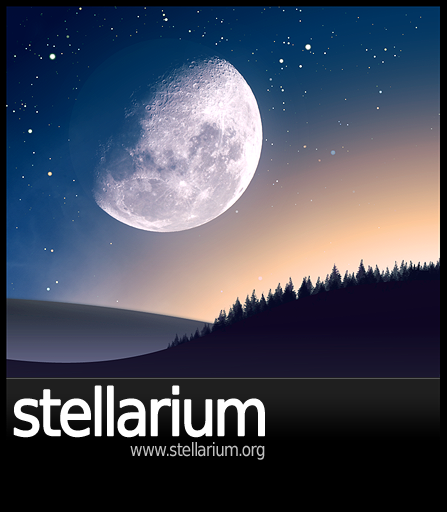
Stellarium is a renowned stargazing app that transforms your device into a virtual planetarium. With a vast database of stars, constellations, and celestial objects, it offers an immersive experience for users. The app’s realistic sky rendering, combined with its detailed information on various celestial bodies, makes it a favorite among amateur astronomers.
User Experience and Interface Highlights:
Stellarium boasts a user-friendly interface that is both intuitive and visually appealing. The app allows users to time travel to view the sky from the past or future, making it a unique tool for understanding celestial movements. Its night mode ensures that users’ night vision isn’t compromised during stargazing sessions.
Pros:
- Extensive database of stars and celestial objects.
- Realistic sky rendering with atmospheric effects.
- Time travel feature to view the sky from different time periods.
- Night mode to protect night vision.
Cons:
- Might be overwhelming for absolute beginners due to its vast features.
- Some advanced features might require in-app purchases.
SkyView Lite
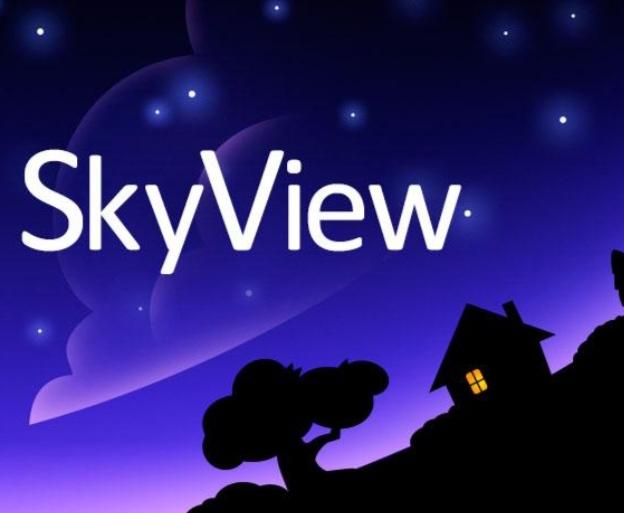
SkyView Lite is a popular and user-friendly stargazing app that allows users to identify stars, constellations, satellites, and more, simply by pointing their device at the sky. With augmented reality (AR) features, it overlays information on the real-time view of the sky, making celestial objects easily identifiable.
User Experience and Interface Highlights:
SkyView Lite offers a seamless experience with its intuitive interface. The AR feature is particularly impressive, allowing users to get real-time information overlaid on their device’s camera view. The app also provides detailed information about each celestial object, making it educational and informative. Its “time travel” feature lets users see the sky from different dates and times.
Pros:
- Augmented reality (AR) feature for real-time identification.
- Detailed information on stars, constellations, and other celestial objects.
- Time travel feature to explore the sky from different dates.
- No internet connection required for most features.
Cons:
- Limited features in the Lite version; premium version offers more advanced capabilities.
- Some users might find the AR feature less accurate in areas with high light pollution.
SkySafari
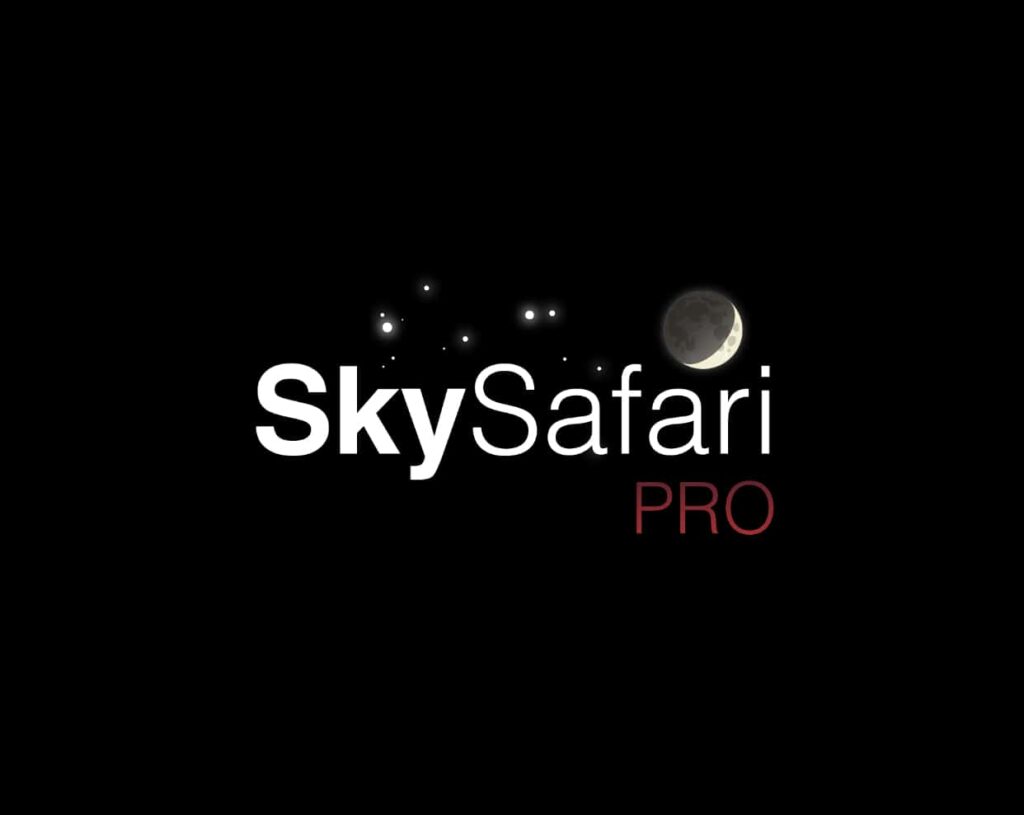
SkySafari is a comprehensive and advanced stargazing app that caters to both beginners and seasoned astronomers. With a vast database and detailed celestial maps, it offers a deep dive into the wonders of the universe.
Overview and Standout Features:
SkySafari boasts a rich database of stars, planets, constellations, satellites, and deep-sky objects. One of its standout features is the telescope control, allowing users to connect the app to compatible telescopes and control them directly from the device. The app also offers detailed descriptions and history of various celestial objects, making it an educational tool. Its “Night Vision” mode ensures that users’ eyes remain adjusted to the dark while using the app.
User Experience and Interface Highlights:
The app’s interface is user-friendly, with smooth navigation and clear graphics. The search function is particularly efficient, allowing users to quickly locate and learn about specific celestial objects. The simulation of celestial events, such as meteor showers or eclipses, offers users a preview of what to expect in the real sky.
Pros:
- Extensive database of celestial objects.
- Telescope control feature for compatible telescopes.
- Night Vision mode for comfortable nighttime viewing.
- Simulation of celestial events for better preparation.
Cons:
- The app has multiple versions (Lite, Plus, Pro) which might be confusing for some users.
- Some advanced features might have a learning curve for absolute beginners.
Star Walk 2
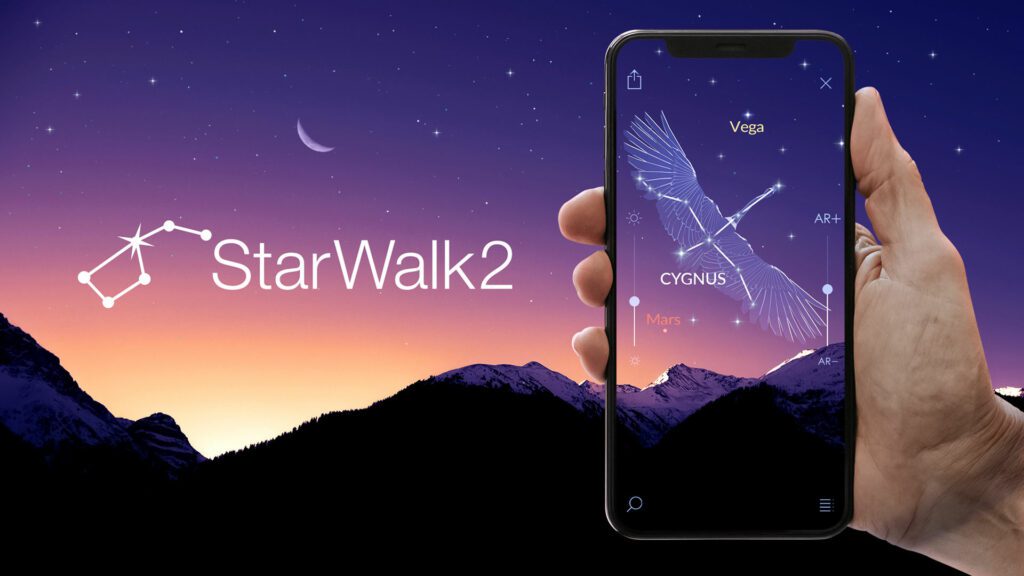
Star Walk 2 is a visually stunning stargazing app that brings the universe to the palm of your hand. With real-time tracking and rich graphics, it’s a favorite among many amateur astronomers.
Overview and Standout Features:
Star Walk 2 offers real-time motion tracking, allowing users to point their device at the sky and identify stars, constellations, and satellites. The app also includes a time machine feature, letting users see the sky from the past or future. Its 3D models of celestial bodies provide a detailed view of planets and their satellites.
User Experience and Interface Highlights:
The app is known for its beautiful and intuitive interface. The graphics are detailed and colorful, making the experience immersive. The app also offers night mode, ensuring that users can stargaze without disturbing their night vision.
Pros:
- Real-time motion tracking.
- Time machine feature for viewing past or future skies.
- Detailed 3D models of planets and satellites.
- Night mode for comfortable viewing.
Cons:
- Some features are behind a paywall.
- Might consume more battery due to its rich graphics.
Mobile Observatory 3

Mobile Observatory 3 is a powerful app designed for those deeply interested in astronomy. It offers a plethora of features that cater to both novices and experts.
Overview and Standout Features:
The app provides detailed information on the moon, planets, and hundreds of thousands of stars. It also offers notifications for astronomical events and has an integrated telescope control.
User Experience and Interface Highlights:
With a straightforward interface, Mobile Observatory 3 ensures that users can easily navigate through its vast amount of information. The app also includes detailed charts and diagrams, enhancing the learning experience.
Pros:
- Comprehensive database of celestial objects.
- Notifications for astronomical events.
- Integrated telescope control.
- Detailed charts and diagrams.
Cons:
- The interface might seem overwhelming to absolute beginners.
- The app is not free, and there’s no trial version.
Special Mention: Unique Stargazing Apps
While the mainstream stargazing apps cater to a broad audience, there are several niche apps that offer unique features or cater to specific user bases. These apps might not be as popular as the giants in the field, but they bring something special to the table.
Exoplanet

Overview:
Exoplanet is an app dedicated to providing users with information about planets outside our solar system. Updated frequently, it offers a comprehensive list of all confirmed exoplanets.
Unique Features:
- Interactive 3D model of our Milky Way.
- Push notifications for new discoveries.
- Filter and search options based on various parameters like distance, size, and discovery method.
Target Audience:
Those particularly interested in exoplanets and the search for habitable worlds.
ISS Detector

Overview:
As the name suggests, this app is designed to help users spot the International Space Station (ISS) and other satellites as they pass overhead.
Unique Features:
- Real-time tracking of the ISS and other satellites.
- Weather conditions and visibility predictions.
- Alarms to notify users shortly before the ISS is visible.
Target Audience:
Space enthusiasts who want to catch a glimpse of human-made objects orbiting Earth.
NightShift: Stargazing & Astronomy

Overview:
NightShift is designed for those who want to stargaze but live in areas with significant light pollution.
Unique Features:
- Light pollution map to find the best nearby stargazing locations.
- Augmented Reality (AR) star map.
- Customizable notifications for celestial events.
Target Audience:
Urban dwellers and those living in areas with high light pollution.
Meteor Shower Calendar

Overview:
This app is dedicated to meteor showers, offering all the information one might need to observe these celestial events.
Unique Features:
- Calendar of all upcoming meteor showers.
- Peak times and expected meteor rates.
- Visibility conditions and moon phase impact.
Target Audience:
Enthusiasts who love meteor showers and want to plan their observations.
Factors to Consider When Choosing a Stargazing App:
Navigating the vast universe of stargazing apps can be as challenging as exploring the night sky. With so many options available, how do you choose the one that’s right for you? Here are some key factors to consider:
Compatibility and Platform Considerations:
Before diving into the features, ensure that the app is compatible with your device. Whether you’re using iOS, Android, or another platform, the app should run smoothly and be optimized for your device’s specifications.
Free vs. Premium:
Many apps offer both free and premium versions. While free versions can be quite comprehensive, premium versions often come with advanced features, ad-free experiences, and more extensive databases. Assess if the additional features in the premium version are worth the investment for your needs.
User Interface and Experience
A good stargazing app should be intuitive and user-friendly. The design should make it easy for users to navigate, search for celestial objects, and access information. Read reviews to gauge the overall user experience and see if it aligns with your preferences.
Database Accuracy and Size:
The primary purpose of a stargazing app is to provide accurate information about celestial objects. Ensure that the app’s database is comprehensive, updated regularly, and sources its information from reliable astronomical databases.
Augmented Reality (AR) Capabilities:
AR can elevate the stargazing experience by overlaying constellations, stars, and other celestial objects on the live view from your device’s camera. If this feature appeals to you, look for apps that offer robust AR functionalities and ensure they work well in your location.
How to Get the Most Out of Your Stargazing App:
Stargazing apps have revolutionized the way we interact with the night sky, making it more accessible and informative for everyone. However, to truly harness the power of these apps, one must know how to use them effectively. Here are some tips to ensure you get the most out of your chosen stargazing app:
Optimize App Usage:
- Location Settings: Ensure your location settings are accurate. Most apps use your location to provide real-time information about the sky above you.
- Calibration: Some apps may require you to calibrate them using your device’s sensors. Follow the app’s instructions for calibration to ensure accuracy.
- Night Mode: Many apps offer a night mode or red-light mode. This preserves your night vision while using the app during stargazing sessions.
Keep Your App Updated:
- Regular Updates: Developers frequently update apps to fix bugs, add new features, or update celestial databases. Regularly updating your app ensures you have the most accurate and up-to-date information.
- Check for New Features: Updates often come with new features. Familiarize yourself with these additions to enhance your stargazing experience.
Combine Multiple Apps:
- Holistic Experience: While one app might excel in star charts, another might be great for tracking satellites or meteor showers. Using multiple apps can provide a more comprehensive view of the night sky.
- Backup: In case one app fails or has issues, having a backup can ensure your stargazing session continues uninterrupted.
- Specialized Apps: Some apps cater to niche interests, such as satellite tracking, ISS spotting, or meteor shower calendars. Having a few specialized apps alongside a general stargazing app can provide a richer experience.
Engage with the Community:
- User Forums and Groups: Many apps have associated online communities or forums. Engaging with these can provide tips, answer queries, and offer a platform to share experiences.
- Share and Learn: Use the app’s sharing features to showcase your observations. You can learn from others and get feedback on your findings.
In conclusion, while stargazing apps are powerful tools, their true potential is unlocked when used effectively and in conjunction with other resources. Whether you’re a novice or a seasoned astronomer, these tips can enhance your night sky explorations and deepen your appreciation of the cosmos.
Conclusion:
In an age where technology permeates every facet of our lives, it’s awe-inspiring to see how it has bridged the vast expanse of the cosmos to the palm of our hands. Stargazing apps have not only democratized the field of astronomy but have also rekindled a sense of wonder in both young and old. They have transformed our smartphones and tablets into windows to the universe, allowing us to gaze upon stars, planets, and galaxies from our backyards, city rooftops, or remote countryside locations.
These apps serve as a testament to human ingenuity, combining our age-old fascination with the night sky with cutting-edge technology. They’ve made what was once the domain of scholars and astronomers accessible to anyone with a smartphone and a sense of curiosity.
For those who have ever looked up at the night sky and wondered about the stories of the stars, the mysteries of the galaxies, or the trajectories of the planets, these apps offer a guided tour. They challenge us to look beyond our immediate surroundings, to contemplate our place in the vastness of the universe, and to always remain curious.
As we move forward, the fusion of technology and astronomy promises even more groundbreaking tools and discoveries. But for now, armed with these stargazing apps, we encourage every reader to step outside, look up, and embark on their own celestial journey. The universe, with all its wonders, awaits.
